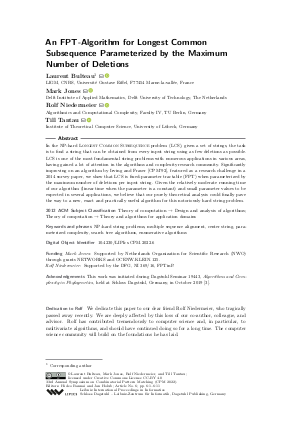@InProceedings{bulteau_et_al:LIPIcs.CPM.2022.6,
author = {Bulteau, Laurent and Jones, Mark and Niedermeier, Rolf and Tantau, Till},
title = {{An FPT-Algorithm for Longest Common Subsequence Parameterized by the Maximum Number of Deletions}},
booktitle = {33rd Annual Symposium on Combinatorial Pattern Matching (CPM 2022)},
pages = {6:1--6:11},
series = {Leibniz International Proceedings in Informatics (LIPIcs)},
ISBN = {978-3-95977-234-1},
ISSN = {1868-8969},
year = {2022},
volume = {223},
editor = {Bannai, Hideo and Holub, Jan},
publisher = {Schloss Dagstuhl -- Leibniz-Zentrum f{\"u}r Informatik},
address = {Dagstuhl, Germany},
URL = {https://drops.dagstuhl.de/entities/document/10.4230/LIPIcs.CPM.2022.6},
URN = {urn:nbn:de:0030-drops-161338},
doi = {10.4230/LIPIcs.CPM.2022.6},
annote = {Keywords: NP-hard string problems, multiple sequence alignment, center string, parameterized complexity, search tree algorithms, enumerative algorithms}
}

 Creative Commons Attribution 4.0 International license
Creative Commons Attribution 4.0 International license

















